Are you considering raising chickens in your backyard? A well-designed chicken coop is crucial for the health and happiness of your birds. However, many first-time chicken keepers make critical mistakes that can lead to stressed birds and reduced egg production.
Building a coop that meets your chickens’ needs requires careful planning. By understanding common pitfalls, you can create a safe and comfortable home for your chicken flock. This guide will walk you through the essential considerations for building a successful chicken coop.
Starting with a chicken coop and a few helpful products can make things easier—but definitely take some time to do your own research. Everyone’s setup is a little different, so it’s all about finding what works best for you and your flock.
This post contains affiliate links. If you purchase through these links, I may earn a small commission at no extra cost to you. Learn more here.
Key Takeaways
- Understand the importance of a well-designed chicken coop for your backyard flock.
- Learn the common mistakes to avoid when building a chicken coop.
- Discover practical solutions to ensure your chickens’ health and happiness.
- Create a safe and comfortable environment for your chickens.
- Avoid costly mistakes that can impact your chickens’ egg production.
Turn your backyard into a chicken haven with this easy-to-follow coop building guide.
The Foundation of Successful Backyard Chicken Keeping
A well-designed chicken coop is crucial for the well-being of your chickens, directly impacting their health, happiness, and egg production. Your coop is more than just a shelter; it’s the cornerstone of successful chicken keeping.
How Your Coop Affects Chicken Health and Egg Production
The coop’s design and features significantly influence your chickens’ health and productivity. Proper ventilation, temperature regulation, and security measures all contribute to a healthy environment that fosters consistent egg production.
Creating a Safe Haven for Your Feathered Friends
Creating a comfortable and secure coop environment is essential for the well-being of your chickens. This includes using appropriate materials, ensuring adequate space, and protecting against predators.
By focusing on these aspects, you can create a thriving environment for your backyard chicken keeping experience, ensuring their health and happiness while enjoying a bountiful egg supply.
Essential Requirements for a Healthy Chicken Coop
To keep your chickens happy and healthy, it’s vital to understand the key requirements of a chicken coop. A well-designed coop is the foundation of a thriving backyard flock.
Space Needs for Happy, Productive Chickens
Adequate space is crucial for the health and productivity of your chickens. Provide at least 2-4 square feet per bird inside the coop and a minimum of 10 square feet per bird in the outdoor run area. This helps prevent stress and behavioral problems.
Critical Features Every Coop Should Have
Several critical features are essential for a healthy chicken coop. These include:
- Proper ventilation to prevent respiratory issues
- Secure predator protection using hardware cloth
- Appropriate roosts and nest boxes
- Proper drainage and elevation
| Feature | Description | Benefit |
|---|---|---|
| Proper Ventilation | Ensures airflow and prevents moisture buildup | Reduces risk of respiratory diseases |
| Secure Predator Protection | Uses hardware cloth to safeguard against predators | Protects your flock from common threats |
| Adequate Roosting Space | Provides 8-12 inches of roosting space per bird | Allows natural sleeping positions |
7 Mistakes to Avoid When Building Your Dream Chicken Coop
To ensure a positive experience for both you and your chickens, it’s crucial to avoid certain mistakes when building your chicken coop. Many beginners face challenges due to lack of research, leading to structural problems and unhealthy living conditions for their flock.
Overview of Common Pitfalls
Building a chicken coop without proper research is one of the most common mistakes. This oversight can lead to inadequate protection and unhealthy conditions. Avoiding these mistakes is key to creating a safe and healthy environment for your chickens.
Some of the critical mistakes include not providing enough space, inadequate predator protection, and poor ventilation design. Each of these mistakes can significantly impact your chickens’ health and productivity.
How These Mistakes Impact Your Flock’s Well-being
The mistakes made when building a chicken coop can have far-reaching consequences on your flock’s well-being. For instance, overcrowding can lead to stress and behavioral issues, while poor ventilation can cause respiratory problems. Understanding these potential pitfalls is essential for creating a thriving backyard flock.
By being aware of these common mistakes, you can take steps to avoid them, ensuring a positive experience for both you and your chickens. This includes providing adequate space, securing the coop against predators, and designing proper ventilation.
Mistake #1: Underestimating Space Requirements
A common pitfall for backyard chicken enthusiasts is misjudging the space required for their flock to thrive. Providing enough space is crucial for the health, happiness, and productivity of your chickens.
Proper Square Footage Inside the Coop
For a healthy and happy flock, it’s essential to provide adequate indoor coop space. Aim for at least 2-4 square feet per chicken inside the coop. This allows for comfortable movement and reduces stress among the birds.
Outdoor Run Space Needs
The outdoor run is just as important as the coop itself. Aim for a minimum of 10 square feet per bird in the outdoor run. More space is always better, as it allows your chickens to exercise and engage in natural behaviors.
The Consequences of Overcrowding Your Flock
Overcrowding can lead to a range of problems, including stressed birds, reduced egg production, and increased disease risk. When chickens are too crowded, they may exhibit behaviors like feather pecking and bullying. To avoid these issues, ensure you have enough space for your flock.
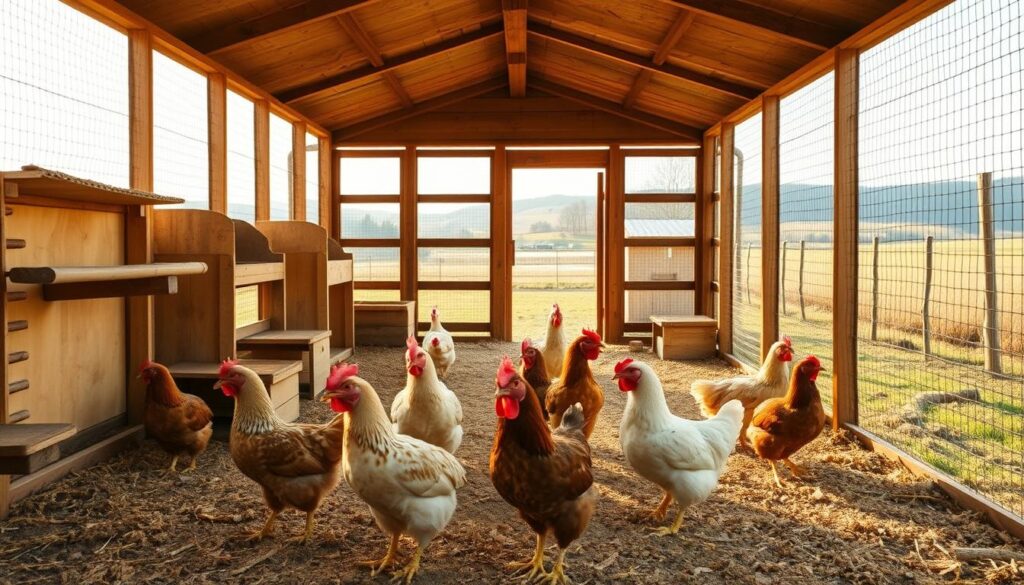
>>Create a secure and snug coop for your chickens with this comprehensive, step-by-step guide. Purchase it here<<
For a small flock of six chickens, you’ll need at least 18-24 square feet of interior coop space and a run of 60+ square feet. Planning for future expansion is also wise, as your flock may grow over time.
- Underestimating space needs can lead to overcrowding, stress, and health issues in your flock.
- Providing adequate space reduces competition for resources and promotes a more peaceful pecking order.
- Future expansion should be considered when building your coop to accommodate potential growth.
Mistake #2: Inadequate Predator Protection
Protecting your flock from predators is not just a precaution; it’s a necessity. A single nighttime visitor can decimate your entire flock in hours, making robust predator protection crucial for any chicken keeper.
Hardware Cloth vs. Chicken Wire: Critical Differences
The first line of defense against predators is using the right materials. Hardware cloth, with its 1/4″ or 1/2″ welded wire mesh, is the only truly effective barrier against predators. Unlike chicken wire, which is designed to keep chickens in, hardware cloth is designed to keep predators out.
As one customer learned the hard way, “Chicken wire is designed to keep chickens in but will not keep predators out.” This critical difference can be the difference between life and death for your flock.
Securing Against Common Predators Like Raccoons
Predators like raccoons are intelligent and dexterous, capable of opening simple latches. To secure your coop, you’ll need locks that require two steps to open, such as a combination of lifting and pulling.
Essential Security Features Every Coop Needs
In addition to strong materials and secure locks, consider these essential security features:
- Buried barriers extending at least 12 inches underground to prevent digging predators.
- A solid floor to prevent access from below.
- Covering the run with hardware cloth to protect against aerial predators like hawks and owls.
| Security Feature | Purpose |
|---|---|
| Hardware Cloth | Protects against predators like raccoons and foxes. |
| Two-Step Locks | Prevents clever predators from opening coop doors. |
| Buried Barriers | Stops digging predators from accessing the coop. |
For more information on securing your coop against even larger predators, consider checking out resources on bear-proof chicken coops.
Mistake #3: Poor Ventilation Design
Proper ventilation is crucial for maintaining a healthy environment in your chicken coop. Without it, you’re creating a breeding ground for bacteria and ammonia that can lead to serious health issues in your chickens.
Balancing Airflow Without Creating Harmful Drafts
A common mistake is confusing ventilation with drafts. Your coop needs consistent airflow without cold air blowing directly on roosting chickens. To achieve this, vents should be placed high on the walls where warm, moist air naturally rises, allowing it to escape while keeping the living area draft-free.
Preventing Respiratory Issues in Your Chickens
Poor ventilation design leads to moisture buildup and ammonia accumulation, creating the perfect environment for respiratory issues in your chickens. By ensuring proper ventilation, you can significantly reduce the risk of these health problems.
Proper Window and Vent Placement
Windows serve dual purposes in your coop: providing natural light that regulates your chickens’ laying cycles and offering additional ventilation options during warmer months. In winter, it’s essential to maintain some level of ventilation to prevent moisture buildup, even if it means partially closing vents to preserve heat. The ideal ventilation system changes with the seasons—more open in summer for cooling and partially closed in winter.
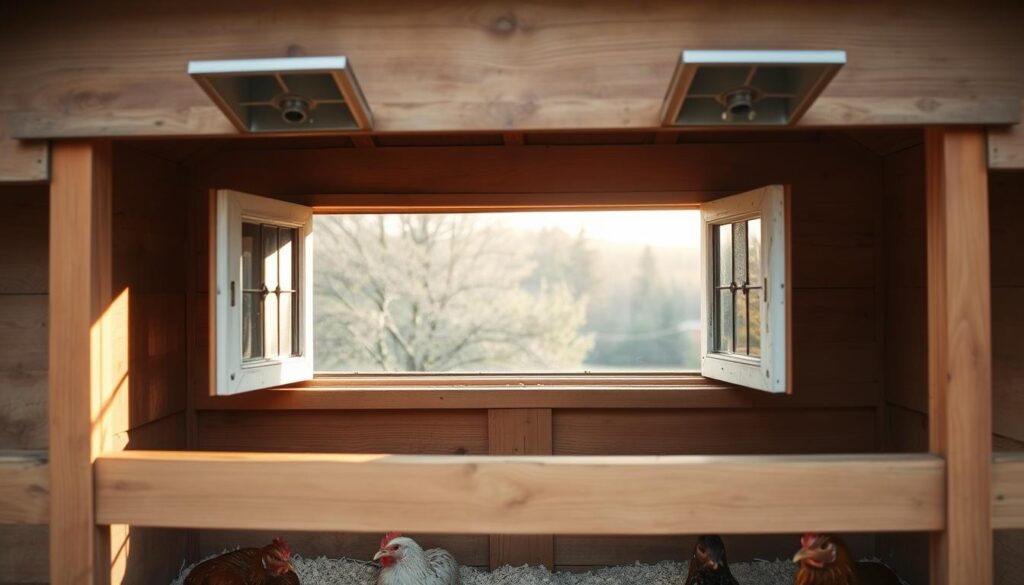
Mistake #4: Using Inappropriate Materials
Using the wrong materials can lead to a host of problems for your backyard chickens. The choice of materials for your chicken coop is critical for its durability and the health of your flock.
Durable Options Like LP SmartSide and Pressure-Treated Lumber
At Wright’s Shed Co., our coops feature LP SmartSide siding, engineered to resist moisture, fungal decay, and termites. This makes it perfect for structures housing animals. We also use pressure-treated lumber for floor joists, ensuring your coop stands strong for years. When using pressure-treated lumber, it’s essential to opt for newer versions treated with ACQ or copper azole to avoid older CCA treatments that contain arsenic.
Materials to Avoid for Chicken Safety
Avoid using materials like untreated particleboard or MDF, as they quickly deteriorate when exposed to moisture and chicken droppings. It’s also crucial to steer clear of materials treated with toxic chemicals or paints containing lead on interior surfaces, as your chickens will peck at accessible surfaces.
Weather-Resistant Considerations for Your Climate
Consider your specific climate when selecting materials for your coop. For instance, metal roofing might be ideal in snowy regions but could create overheating issues in hot climates without proper insulation. Ensuring your coop is made with weather-resistant materials will help maintain a healthy environment for your chickens.
- Choose durable, weather-resistant materials to prolong the life of your coop.
- Avoid materials that can harm your chickens or deteriorate quickly.
Mistake #5: Choosing the Wrong Location
One of the most critical decisions you’ll make when building a chicken coop is choosing the right location. The location can make or break your chicken-keeping experience, affecting factors such as moisture levels, temperature regulation, and predator exposure.
Drainage and Elevation Considerations
Good drainage is essential for maintaining a dry and healthy coop. Placing your coop on high ground prevents flooding and moisture problems, reducing the risk of disease among your flock. Elevating your coop 1-2 feet off the ground further improves ventilation and protects against ground moisture.
| Location Factor | Importance | Benefit |
|---|---|---|
| Drainage | High | Prevents flooding and moisture issues |
| Sun Exposure | Medium | Provides natural warmth and helps regulate temperature |
| Elevation | High | Improves ventilation and reduces disease risk |
Balancing Sun Exposure and Shade
Carefully consider sun exposure when choosing a location for your coop. In most climates, aiming for morning sun and afternoon shade provides natural warmth while preventing overheating during the hottest parts of the day.
Positioning Against Prevailing Winds
Position your coop with its solid back wall facing prevailing winds to create a natural windbreak. This protects your chickens from drafts while still allowing for proper ventilation, ensuring a healthy environment for your flock.
Design the ideal chicken coop with confidence—this guide walks you through every step. Available for purchase now.

Mistake #6: Difficult-to-Clean Design Features
One of the most overlooked aspects of chicken coop design is how easily it can be cleaned. A clean coop is crucial for the health of your chickens and directly impacts egg production. “A clean coop means healthy chickens and better egg production,” emphasizing the importance of design features that facilitate easy cleaning.
Droppings Boards and Removable Trays
Incorporating features like droppings boards or removable trays under roosts can significantly simplify the cleaning process. These features allow you to collect the majority of waste easily, making daily and weekly cleaning more efficient.
Establishing an Effective Cleaning Routine
To maintain a clean and healthy coop, establish a consistent cleaning routine. Daily tasks should include collecting eggs, checking water and feed, and observing your birds for any health issues. Weekly tasks involve removing droppings from boards and refreshing bedding as needed.
The Deep Litter Method for Winter Management
Many chicken keepers recommend the “deep litter method” for winter management. This approach involves allowing bedding to build up and compost in place, generating heat while reducing the need for frequent cleaning during cold months.
By incorporating these design features and cleaning strategies, you can maintain a clean, healthy environment for your chickens, ensuring better egg production and overall well-being.
Mistake #7: Ignoring Local Regulations and Neighbors
One of the most significant oversights in backyard chicken keeping is neglecting local regulations and neighbor considerations. Before you start your chicken-keeping journey, it’s essential to research and comply with local ordinances and zoning laws.
Understanding Zoning Laws and HOA Rules
Many cities and neighborhoods have specific regulations regarding backyard chickens, including flock size limits, rooster restrictions, and coop placement rules. Check with your local government or homeowners association (HOA) to ensure you’re compliant with all requirements, avoiding potential fines or removal of your flock.
Maintaining Good Neighbor Relations
Proactively communicating with your neighbors about your plans to keep chickens can help address concerns and foster a positive relationship. Consider offering to share eggs once your flock begins laying as a gesture of goodwill.
Noise and Odor Management Strategies
Implementing effective odor management strategies, such as regular cleaning and proper composting of waste, can prevent smells from becoming a neighborhood issue. Positioning your coop thoughtfully in relation to neighbors’ windows and outdoor living spaces can also minimize potential noise disturbances.

By being mindful of local regulations and neighbor concerns, you can enjoy your backyard chickens without unnecessary stress or conflict.
Walk-In Coops: Worth the Investment?
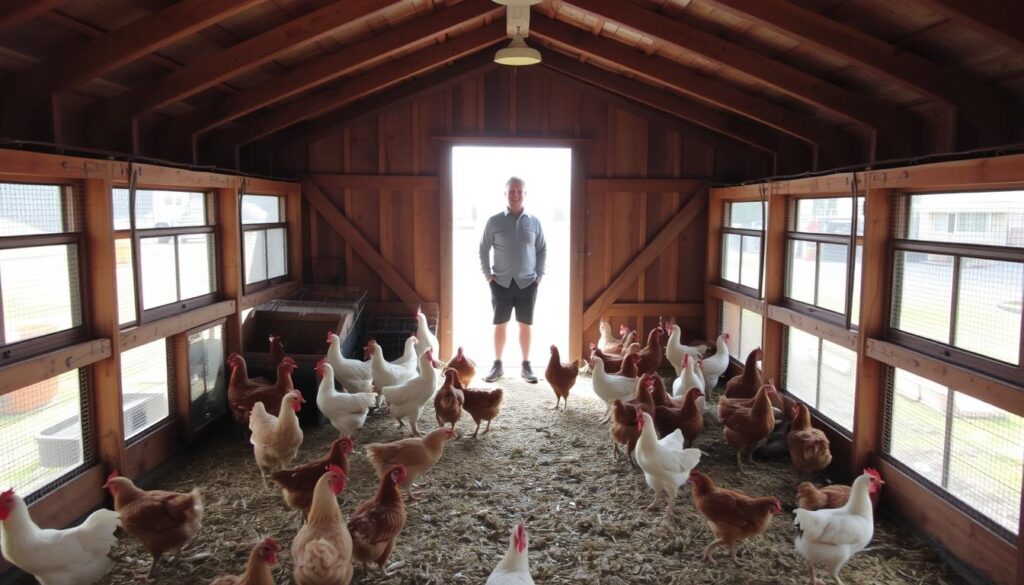
The decision to invest in a walk-in chicken coop can be a game-changer for both you and your chickens. These spacious coops offer numerous benefits, making daily chicken keeping more enjoyable and sustainable in the long term.
Benefits of Full Standing Height
One of the primary advantages of walk-in coops is their full standing height, typically over 6 feet at the center. This design feature transforms maintenance from an uncomfortable chore to a pleasant interaction with your flock, encouraging more consistent care.
Ideal Flock Size for Walk-In Models
Walk-in coops are particularly suited for flocks of 10-15 hens, providing 30-60 square feet of interior space. This generous space ensures optimal health and productivity for your chickens.
Premium Features That Make Maintenance Easier
Premium walk-in coops often include features like exterior nest box access, dedicated storage areas for supplies, and multi-level roosts. These features maximize both chicken comfort and owner convenience, making daily maintenance tasks easier and more efficient.
Mobile Chicken Tractors: The Movable Solution
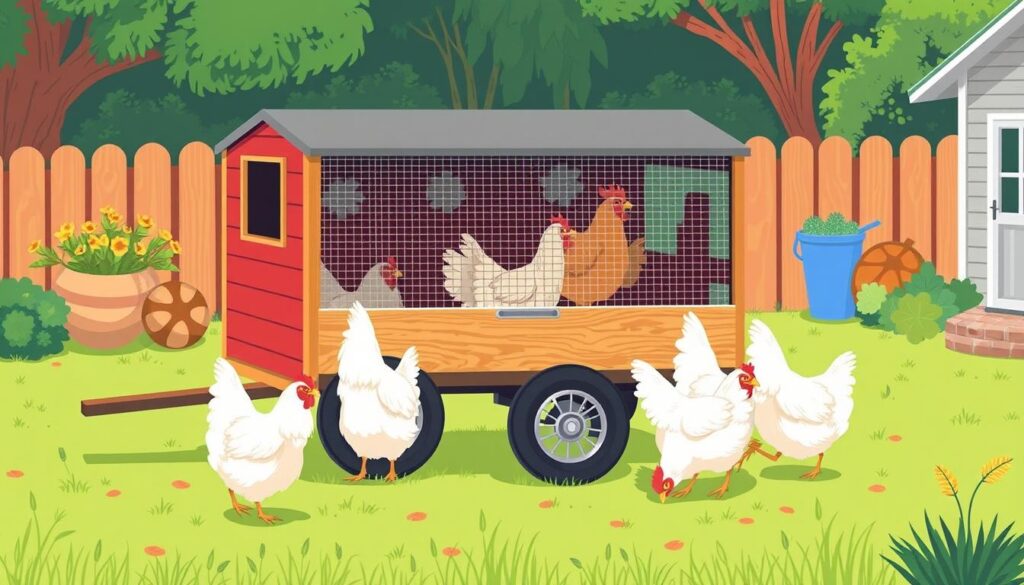
Mobile chicken tractors offer a unique approach to raising chickens by allowing them to roam on fresh ground daily while being protected from predators. These movable coops are designed to be lightweight yet sturdy, making it easy to relocate them around your yard.
Design Elements for Easy Movement
The design of mobile chicken tractors typically includes ergonomic handles, wheels, or skids, allowing for easy relocation by one person. This feature is crucial for maintaining the health and happiness of your chickens.
Benefits of Fresh Ground Access
Providing your chickens with daily access to fresh ground leads to more nutritious eggs and healthier birds. It also aids in lawn fertilization as the chickens distribute their manure.
Best Practices for Rotation Schedules
To maximize the benefits, establish a consistent rotation schedule. Moving the tractor every 1-3 days prevents overgrazing and allows adequate foraging time, significantly reducing parasite loads in your flock.
Urban Chicken Coops: Small Space Solutions
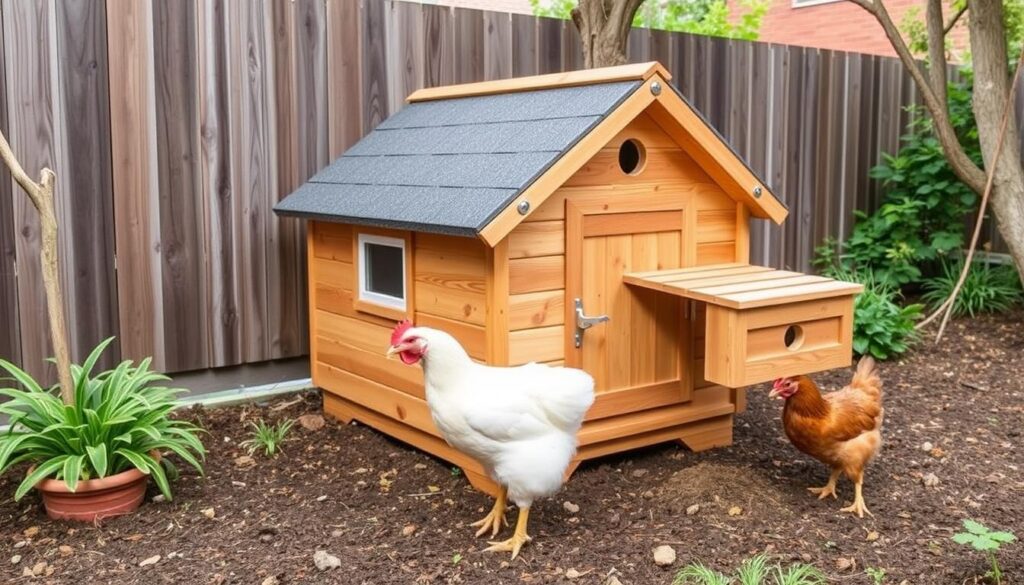
Compact urban chicken coops are perfect for city dwellers with limited space. These coops are designed to be space-efficient, allowing you to keep 2-4 hens even in the smallest of backyards.
Space-Efficient Designs for City Dwellers
Our urban chicken coops are designed with city living in mind. They typically measure just 4’×6′ or smaller, making them ideal for tight spaces. Despite their compact size, they pack all the essentials for keeping your hens happy and healthy.
Neighbor-Friendly Features for Close Quarters
Urban chicken coops require thoughtful design to maximize limited space while maintaining all essential features for chicken health and happiness. Features like extra insulation for noise reduction, strategic ventilation for odor management, and attractive exteriors that enhance property aesthetics are crucial.
HOA-Compliant Design Elements
Many urban areas have HOA rules that govern backyard structures. Our coops are designed with these regulations in mind, often featuring height restrictions under 6′, architectural elements that complement neighborhood aesthetics, and discreet positioning to minimize visibility.
DIY vs. Pre-Built Coops: Making the Right Choice
When deciding between building your own chicken coop or purchasing a pre-built one, several factors come into play. Your decision will depend on your skills, available time, and resources.
Cost Comparison
A DIY coop can cost between $300-$2,000, depending on materials and size, while a quality pre-built coop can range from $500-$5,000. The initial cost is just one aspect to consider.
Time Investment and Skill Requirements
Building your own coop requires a significant time investment, typically 2-7 days, and basic carpentry skills. In contrast, a pre-built coop is ready to use immediately.
Warranty and Longevity Considerations
While a DIY coop offers customization, it usually lacks a warranty unless it’s a kit. Pre-built coops, however, often come with warranties and are built to last, maintaining a higher resale value.
Climate-Specific Adaptations for Your Chicken Coop
The climate in your area plays a significant role in determining the design and features of your chicken coop. A well-designed coop can keep your flock comfortable and healthy throughout the year, regardless of weather extremes.
Winterizing Strategies for Cold Weather
In cold climates, proper insulation in the walls and ceiling is crucial, but it’s equally important not to block ventilation. The deep litter method can help generate natural heat, while eliminating drafts maintains air exchange. This approach ensures your chickens stay warm without compromising air quality.
Cooling Solutions for Hot Climates
For hot climates, maximizing ventilation with additional windows, vents, and sometimes fans is essential. Using reflective roofing materials can reduce heat absorption, and strategic shade positioning helps keep temperatures manageable during heat waves. These features work together to create a cooler environment for your flock.
Moisture Management in All Seasons
Moisture management remains critical in all seasons. Excess humidity in winter can cause frostbite, while summer moisture can exacerbate heat stress and promote disease. Ensuring good airflow and using materials that don’t retain moisture can help mitigate these issues.
| Climate | Key Adaptations | Benefits |
|---|---|---|
| Cold | Insulation, Deep Litter Method | Warmth, Reduced Frostbite Risk |
| Hot | Maximized Ventilation, Reflective Roofing | Cooler Temperatures, Reduced Heat Stress |
| All | Moisture Management | Reduced Disease Risk, Healthier Flock |
As the saying goes, “A chicken is only as healthy as its coop.” Ensuring your coop is adapted to your climate is crucial for the well-being of your flock. By implementing these climate-specific adaptations, you can create a safe and healthy environment for your chickens year-round.
“A well-ventilated coop backed by scientific research shows significantly healthier birds with fewer respiratory issues.”
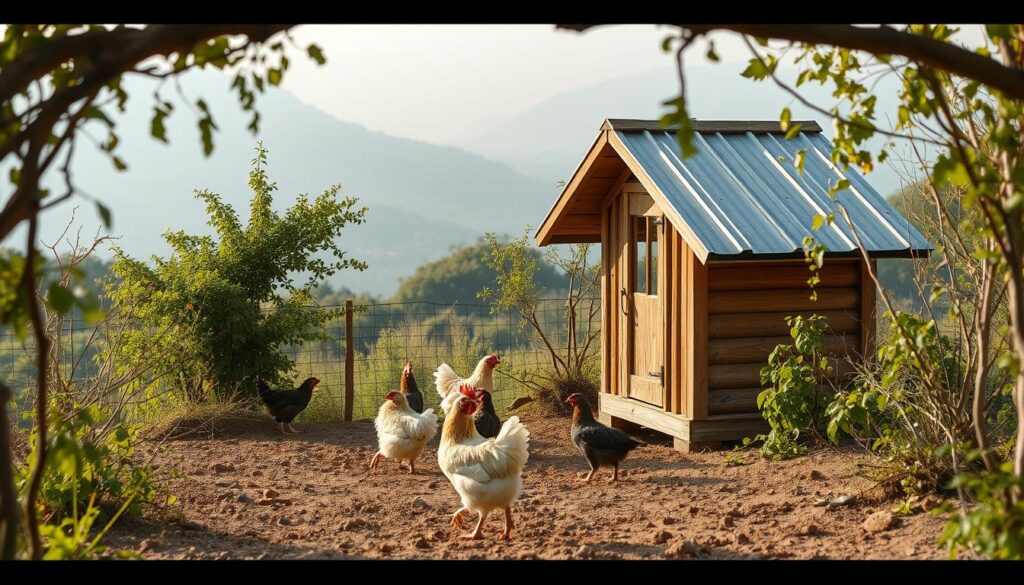
Budget-Friendly Solutions That Don’t Compromise Safety
You can create a safe and secure chicken coop without breaking the bank by making strategic decisions. Building a coop on a budget doesn’t mean you have to sacrifice the well-being of your flock.
Where to Save and Where to Splurge
When it comes to building a budget-friendly chicken coop, it’s essential to know where to allocate your resources. Invest in proper predator protection materials like hardware cloth and quality locks to ensure your flock’s safety. These elements are crucial and should not be compromised.
Repurposing Materials Safely
Repurposing materials can be a cost-effective way to build your chicken coop. Consider using reclaimed lumber for non-structural elements or repurposed windows with intact glass. Always ensure that the materials you repurpose are safe and functional.
| Material | Repurposing Idea | Safety Consideration |
|---|---|---|
| Reclaimed Lumber | Non-structural elements (e.g., nesting box trim) | Ensure the lumber is free from nails and rot |
| Old Windows | Coop windows or ventilation | Verify that the glass is intact and secure |
| Upcycled Hardware | Doors, hinges, and latches | Check that the hardware is fully functional |
Phased Building Approaches
A phased building approach allows you to start with a basic but secure coop and add features over time as your budget allows. This method helps distribute the cost and ensures that your coop remains safe and functional from the outset.
Conclusion: Creating a Safe, Healthy Home for Your Flock
The key to a successful chicken-keeping experience lies in avoiding common mistakes and creating a safe, healthy home for your chickens. By doing so, you’ll be investing in the well-being of your backyard flock. Ensuring adequate space, proper ventilation, and predator protection is crucial.
Consider your climate, local regulations, and maintenance preferences when finalizing your coop design. A well-designed coop transforms chicken keeping into a rewarding experience, providing fresh eggs and the joy of watching healthy chickens.


